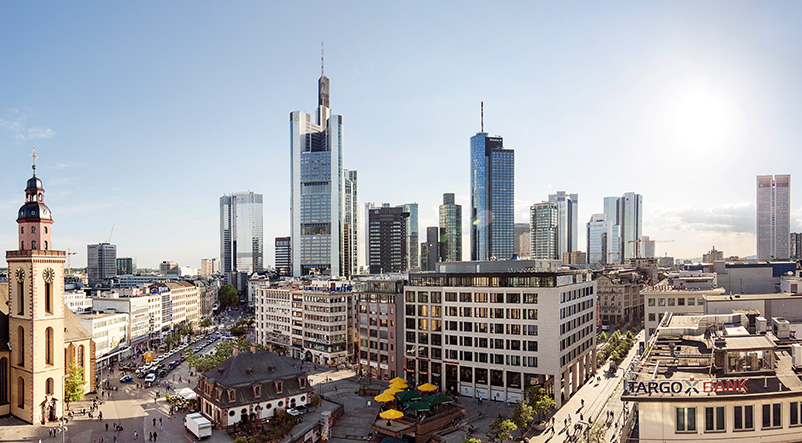
European real estate market on cusp of a change
Signs are emerging that European real estate may have reached a bottom and is about to embark on a period of growth. But the next cycle is likely to be very different. Here’s why.
Originally published June 26, 2024 by Fidelity International.
Written by Kim Politzer, Director of Research, European Real Estate, and Nina Flitman, Senior Writer.
Highlights
- A global divergence
- Rents will drive this cycle
The European real estate market may have the turning circle of an oil tanker, focused as it is on long-term investments. But while the movement might be unwieldy and slow, you can still spot the shift in direction.
The latest data reinforces Fidelity International’s view that we are close to – if not already at – the bottom of the market, with prices stabilizing and potentially on the cusp of turning positive.
Valuations across European industrial, retail and office properties all experienced their shallowest quarter-on-quarter declines since April 2022.
The value of residential buildings returned to positive growth. It might only have been an increase of 0.2%, but it comes after a fall of more than 13% in two years.
Looking at the overall performance of the European real estate market, positive incomes exceeded the negative capital growth, meaning that returns at the asset level were positive for the first time since 2022. [1]
The latest figures cover deals completed in the first few months of the year, most of which will have been negotiated in the second half of 2023. So, while dealmaking in the first quarter of 2024 was at one of the lowest levels of the last decade, [2] the lag in the data means soft signals are even more important for monitoring current market sentiment. The good news is that Fidelity International is already seeing signs of increasing activity.
One broker report suggests the number of U.K. offices on the market actually grew in the first half of the year. [3] The UK is typically a bellwether for the rest of Europe, and Fidelity International believes the lag between the two markets is shortening, meaning the uplift in office space sales could be repeated across the continent relatively soon.
Anecdotes support the view that this uptick is already underway. Agents and lawyers are telling Fidelity International that sellers are now approaching investors with off-market deals. Although it’s impossible to verify the volume of these private transactions, such a resurgence would illustrate sellers’ belief that appetite for their assets is improving. A pickup in investment activity should soon follow.
The buyer profile seems to be becoming more local too. The London market is traditionally dominated by overseas investors, and while one or two deals can skew the data of a thinly traded market, the numbers show domestic players are taking a larger role.
The biggest factor supporting Fidelity International’s expectations of a rebound is the rate move announced by the European Central Bank (ECB) in early June. While a cut of 25 basis points is unlikely to significantly reduce borrowers’ debt costs, the change in policy is more about signalling a direction of travel by the central bank, which in turn will boost investors’ confidence to make new deals. Fidelity International expects to start seeing a change in investor momentum in the third and fourth quarter as a result of the ECB’s cut.
A global divergence
While the outlook in Europe is strengthening, there are fewer reasons to be so optimistic about the U.S. market. Although Fidelity International anticipates the U.S. Federal Reserve will soon track the ECB more closely, the differences between the two markets run deeper. The recovery of U.S. real estate remains far behind its European peer despite the strong macroeconomic environment across the Atlantic.
U.S. repricing is slower than in Europe, with capital values continuing to fall, driven by poor sentiment around office buildings. Fidelity International expects this to be a theme for much of the rest of the year as headlines about the sluggish return to the workplace dominate. The perception could drag the European office sector down too, suppressing values in a lower-for-longer scenario, although Fidelity International believes that the underlying structures of these two regional markets are fundamentally distinct.
Asia, on the other hand, offers a different challenge to investors. Here, sentiment has been far more robust, boosting valuations, but it means fewer opportunities to find nuggets of value as with the mispriced assets of Europe and the U.S. However, mature markets such as Australia, Japan, South Korea and Singapore continue to offer a low-volatility option and a varied pricing dynamic for buyers.
Rents will drive this cycle.
One great benefit of real estate’s tanker-like reaction speeds is that it’s almost impervious to short-term volatility. Long-term trends are the thing to watch. While the European market should start to benefit from an edging down in interest rates, the extraordinary period of zero interest rate policy that followed the global financial crisis is unlikely to be repeated. So, while performance in the last cycle was driven by yield compression in that low-rate environment, Fidelity International believes returns in the next will be driven by rental growth.
From a core investment perspective, this means gauging where there’s likely to be long-term interest from tenants. For example, while the residential market still looks fairly expensive in yield terms, Fidelity International anticipates strong rental growth in Europe because of the demographic shift taking place across the region. The population on the continent may be falling, but as it ages the number of households grows to accommodate more elderly, single-person residences. This should support residential rental demand in the long term. It also suggests benefits for sectors such as life-sciences real estate.
A less encouraging sector is retail, which has been through its own dramatic evolution over the past ten years as shoppers moved online. In many markets – Northern Europe in particular – there is just too much vacant retail space to prompt investors’ interest. Bucking this trend are assets in specific locations with compelling stories where buyers are themselves willing to manage tenants and the shorter leases they’re now after.
But the greatest shift witnessed in the European market over the last cycle has been the increased focus on sustainability. With deadlines for emissions targets rapidly approaching, the green credentials of all types of buildings have become the number one consideration for both tenants and investors. Green premiums are now prevalent and are likely to be the single most important trait of the new investment era.
[1] According to data from the MSCI Global Quarterly Property Fund Index for Q1 2024.
[2] At 33.47 billion euros, the quarterly volume for European investment activity across all sectors was the eleventh lowest since 2007.
[3] “UK Owners Hoist ‘For Sale’ Signs Over Office Buildings: Volume of Office Buildings Up for Sale Jumps to a Six-Year High,” CoStar, June 2024.
Issued by Fidelity Investments Canada ULC (“FIC”). Unless otherwise stated, all views expressed are those of Fidelity International, which acts as a subadvisor in respect of certain FIC institutional investment products or mandates.
For institutional use only.
This document is for investment professionals only and should not be relied on by private investors.
This document is provided for information purposes only and is intended only for the person or entity to which it is sent. It must not be reproduced or circulated to any other party without the prior permission of Fidelity.
This document does not constitute a distribution, an offer or solicitation to engage the investment management services of Fidelity, or an offer to buy or sell or the solicitation of any offer to buy or sell any securities in any jurisdiction or country where such distribution or offer is not authorized or would be contrary to local laws or regulations. Fidelity makes no representations that the contents are appropriate for use in all locations or that the transactions or services discussed are available or appropriate for sale or use in all jurisdictions or countries or by all investors or counterparties.
This communication is not directed at and must not be acted on by persons inside the U.S. and is otherwise only directed at persons residing in jurisdictions where the relevant funds are authorized for distribution or where no such authorization is required. Fidelity is not authorized to manage or distribute investment funds or products in, or to provide investment management or advisory services to persons resident in, mainland China. All persons and entities accessing the information do so on their own initiative and are responsible for compliance with applicable local laws and regulations and should consult their professional advisors.
Reference in this document to specific securities should not be interpreted as a recommendation to buy or sell these securities but is included for the purposes of illustration only. Investors should also note that the views expressed may no longer be current and may have already been acted upon by Fidelity. The research and analysis used in this documentation is gathered by Fidelity for its use as an investment manager and may have already been acted upon for its own purposes. This material was created by Fidelity International.
Past performance is not a reliable indicator of future results.
This document may contain materials from third parties which are supplied by companies that are not affiliated with any Fidelity entity (third-party content). Fidelity has not been involved in the preparation, adoption or editing of such third-party materials and does not explicitly or implicitly endorse or approve such content.
Fidelity International refers to the group of companies which form the global investment management organization that provides products and services in designated jurisdictions outside of North America. Fidelity, Fidelity International, the Fidelity International logo and F symbol are trademarks of FIL Limited. Fidelity only offers information on products and services and does not provide investment advice based on individual circumstances.
©2024 Fidelity Investments Canada ULC. All rights reserved.


